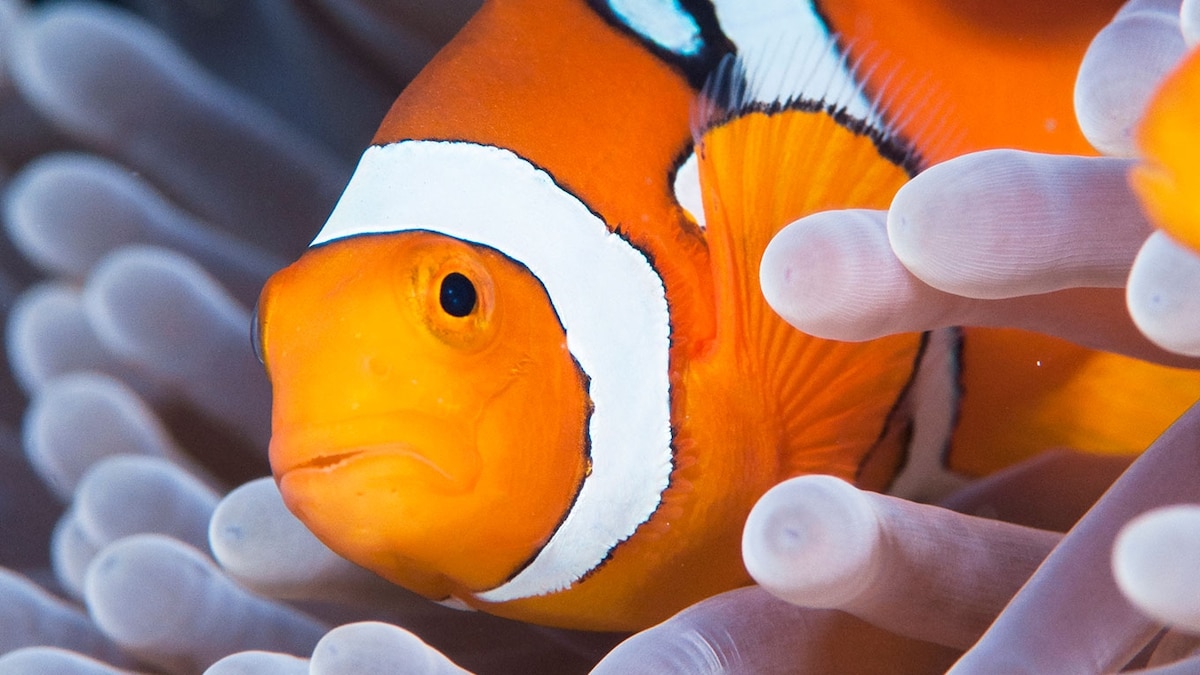Now Reading: How do clownfish survive a heat wave? By shrinking themselves down
-
01
How do clownfish survive a heat wave? By shrinking themselves down
How do clownfish survive a heat wave? By shrinking themselves down

As she checked the measurements again, Ph.D. student Melissa Versteeg was worried something was wrong with her figures. The fish seemed to be shrinking.
“She was measuring them three times,” says Theresa Rueger, a marine biologist who worked with Versteeg at Newcastle University in England. “She had several people measuring them at the same time to really make sure that we’re confident with the numbers.”
But the measurements were correct. Versteeg’s data showed that the individual clown anemonefish (Amphiprion percula) were actually getting shorter during a marine heat wave.
The findings—published in the journal Science Advances—mark the first ever observations of a coral reef fish shrinking because of environmental stressors. Scientists have noticed some fish shrinking at a population level—larger animals might be removed by fishing or the species is evolving to be smaller. But confirming that individual fish are getting shorter is rare because of how hard it is, typically, to catch and measure the same fish repeatedly. The researchers believe that shrinking might increase the clownfishes’ chance of surviving a heat wave.

Amphiprion percula clownfish, like this one shown during the 2023 marine heat wave in Kimbe Bay, can control their growth under certain circumstances.
Photograph By Morgan Bennett-Smith
Impacts of a marine heat wave
The surprising discovery was entirely accidental. “We actually didn’t set out to study the heat wave in the first place,” says co-author Rueger.
Versteeg, the lead author, was monitoring how environmental conditions affect breeding pairs of wild clownfish in Kimbe Bay, Papua New Guinea. When a heat wave hit, pushing water temperatures 4°C above the long-term average, “we decided that she was going to follow them throughout the heat wave,” says Rueger.
As part of the scientists’ routine monitoring, they recorded temperature every few days and measured the size of the anemonefish every month from February to August 2023.
Scuba divers catch the clownfish with an aquarium net and measure them precisely using calipers. The whole process takes a trained scientist less than 30 seconds per fish, “and then they’re back in the anemone, none the wiser,” she says.
The results were astounding. Seventy-one percent of the dominant females and 79 percent of the breeding male shrank at least once during the study period. Some of these “shrinkers” could have a growth spurt to catch up more quickly.
What’s more, 41 percent of the fish that got smaller did so several times—and fish that got smaller along with their breeding partner were more likely to survive.
You May Also Like
Why are clownfish shrinking?
Further studies are needed to get to the bottom of the mystery of why these fish shrink when water temperatures increase.
Clownfish are already known to have a remarkable ability to control their growth in certain circumstances. When a female, usually the largest and most dominant in the group, dies, the large male turns into a female and the next biggest male becomes her breeding partner. If a space becomes available above them in the pecking order, the fish can supercharge their growth to outgrow their competitors. “Once they have that spot, then they’ll stop the fish underneath it from growing,” says Rueger.
Regulating their growth in this way allows them to avoid conflict—if the dominant pair thinks one of the subordinates is getting too big, they kick them out of the anemone where they will be unable to survive. “They can stop growing themselves to not piss off the fish that is right above them in the hierarchy,” she adds. Conflict uses energy so avoiding this means they can focus their resources on survival.
But shrinking? This is new. Clownfish are known to match the size of their anemone home. So if anemones are stunted by marine heat waves, it could be possible that their houseguests might need to shrink to squeeze inside.
Another possibility is that the fish are responding to oxygen or food availability. “If you’re small, you obviously need less food, and you’re also more efficient in foraging a lot of the time,” says Rueger.
More animals are shrinking in a warming world
The clownfish study is just the latest finding that explains how animals are adapting by shrinking in a warming world.
Marine iguanas reduce their body length during El Niño years and the size of juvenile salmon is affected by environmental conditions.
“The suggestion that physical characteristics—in this case, size—are changing, could be indicative of increased resilience,” says Elizabeth Talbot, a marine ecologist at Plymouth Marine Laboratory in England who wasn’t involved in the study. There are downsides too. “Smaller animals generally produce fewer offspring.”
Many animals around the world are getting smaller, says Alexa Fredston, a quantitative ecologist at University of California, Santa Cruz, who wasn’t involved in the study. One notable example is birds, which some researchers suggest is also linked to warming climates.
But overall, it is challenging to understand why some animals are smaller, on average, than they used to be. That’s partly because “we usually have information on body size at the scale of populations—such as all the fish caught in a fishery, or all the migrating birds observed in a year—rather than in one individual over time,” she says.
By measuring individual fish, “the results paint a fascinating and complex picture of how individual animals respond to a prolonged marine heat wave,” Fredston says. For Rueger, this fascinating discovery is bittersweet. She notes: “We were setting out to study these fish, not necessarily to document their demise.”

























